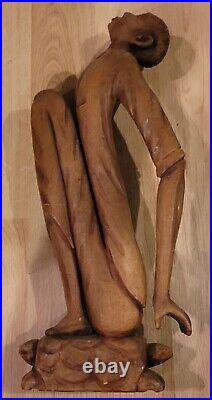
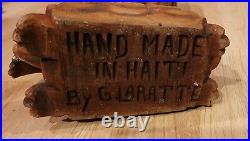
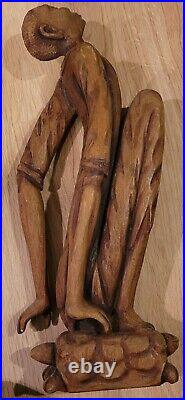
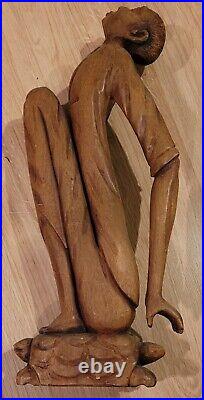

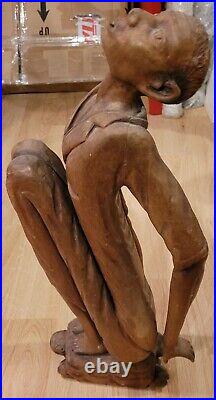

A FANTASTIC HAITIAN SCULPTURE BY HAITIAN 1ST GENERATION HAITIAN ARTIST GEORGES LARATTE MNEASURING APPROXIMATELY 9 X 4 X 21 INCHES. Cap-Haitien, Haiti, 1933; active Haiti, 1988. MONOGRAPHS AND SOLO EXHIBITIONS. GENERAL BOOKS AND GROUP EXHIBITIONS. BLONCOURT, GERALD and MARIE-JOSE NADAL-GARDERE. La Peinture Haitienne / Haitian Arts. Paris: Editions Nathan, 1986. Over 100 color plates, photos of artists, chronols. On individual artists, general chronology, index of artists which seems to end with W in all copies we have seen. Many dozens of artists are listed only by name in the index with no further information and no illustration. By Gesner Armand; texts by Bloncourt, Dewitt Peters; chronols. By Pierre Monosiet and Marie-Jose Nadal. In French and English. Important inclusion of the broader group of Haitian artists, including many hitherto little-noted women painters and modernists, also some sculptors in spite of the book’s title. Includes: Gesner Abelard, Willy Abelard, Jocelyn Agenor, Leon Agnant, Gerald Alexis, Gabriel Alix, Ralph Allen, Jean-Claude Almonor, Occide Almonor, Volvick Almonor, Fritzner Alphonse, Michel-Ange Altidor, Hector Ambroise, Jackson Ambroise, Xavier Amiama, Montas Antoine, Gesner Armand, Gesner Armand, Georges Auguste, Wilfrid (Frido) Austin, Forest Avril, Castera Bazile, Mario Benjamin, Rigaud Bénoit, Wilson Bigaud, Roland Blain, Fabolon Blaise, Serge Moléon Blaise, Saint-Louis Blaise, Sisson Blanchard, Smith Blanchard, Gerald Bloncourt, Noemie Clainville Bloncourt, Ludovic Booz, Maurice Borno, Jean-Baptiste Bottex, Seymour Etienne Bottex, Henry Robert Brésil, Murat Brierre (sculptor), Bourmond Byron, Robert St. Brice, Jean-Claude Castera, Marie-Hélène Cauvin, Dieudonné Cédor, Ralph Chapoteau, Etienne Chavannes, Jacques-Richard Chéry, Préfète Duffaut, Raphael Denis, Villard Dennis, Rose-Marie Desruisseaux, André Dimanche (sculptor), Roland Dorcély, Guy A. Dorcin, Nicholas Dreux, Abner Dubic, Henri Dubreuil, Gervais Emmanuel Ducasse, Alfred Dujour, Joubert Duperrier, Odilon Duperrier, Edouard Duval-Carrié, Jacques Enguerrand-Gourgue, Franck Etienne, Levoy Exil, Celestin Faustin, Lafortune Felix, Gerard Fombrun, Jacques Gabriel, Serge Gay, Max Gerbier, Jacques Geslin, Alexandre Gregoire, Elsie Haas, Georges Hector, Calixte Henry, Edith Hollant, Hector Hyppolite, Saincilus Ismael, Harry Jacques (aka Arijac), Eugene Jean, Francoise Jean, Nehemy Jean, Jean-Baptiste Jean, Carlo Jean Jacques, Eric Jean-Louis, Henri Jean-Louis, Guy Joachim, Antonio Joseph, Casimir Joseph, Fritz-Edouard Joseph, Jasmin Joseph, Nacius Joseph, Pierre Joseph, Reyald Joseph, Wifredo Lam, Gisou Lamothe, Georges Laratte, Franklyn Latortue, Philton Latortue, Lyonel Laurenceau, Peterson Laurent, Luckner Lazard, Hervé Lebreton, Jean-Claude Legagneur, Adam Leontus, Georges Liautaud (sculptor), Jacques Liautaud, Janvier Louisjuste, Joseph Louisjuste, Seresier Louisjuste, Franck Louissaint, Ernst Louizor, Andrée Malebranche, Elzire Malebranche, Descollines Manes, Albert Mangones, Monique Mangones, Michele Manuel, Emmanuel Merisier, Ronald Mevs, Madsen Mompremier, Pierre Monosiet, Amerigo Montagutelli, Sully Moreau, Abner Mortimer, Abraham Mucius, Cesar Muller, Frantz Multidor, Gilda Thebaud Nassief, Andrée Georges Naude, André Navel, Paul Nemours, Vincent Nemours, Jacqueline Nesti, André Normil, Hervé Normil, Nooz, Charles Obas, Antoine Obin, Claude Obin, Donald Obin, Harrison Obin, Henri-Claude Obin, Jean-Marie Obin, Michaelle Obin, Michel Obin, Othon Obin, Philomé Obin, Seneque Obin, Sully Obin, Télémaque Obin, Gerard Olivier, Raymond Olivier, Daniel Orelus, Frantz Oriol, Felipe Orlando, Rémy Paillant (as Paillan), Pierre Pailliere, Roland Palanquet, Francis Paraison, Robal Paris, Rev. Jean Parisot, André J. Pascal, Damien Paul, Gerard Paul, Manno Paul, Jean-Baptiste Pericles, Frida Perou, Clara Petit, Yves Phanor, Prosper Phildor, Robert Philippe-Auguste, Salnave Philippe-Auguste, Marilene Phipps, Viviane Phipps, André Pierre, Antoine Pierre, Fernand Pierre, Frederic Pierre, René Pierre, Sonny Pierre, Vierge Pierre, Willy Pierre, Wilner Pierre, Evans Pierre-Augustin, Pierre Pierre-Canel, Emmanuel Pierre-Charles, Immacula Pierre-Louis, Prospere Pierre-Louis, Raymond Pierre-Louis, Wesner Pierre-Louis, Louis Vergniaud Pierre-Noel, Emmanuel Pierrette, Max Pinchinat, Enock Placide, Dieudonné Pluviose, Ronel Pointdujour, Serge Pointdujour, Fontenel Pointjour, Louverture Poisson, Jerome Polycarpe, Lamy Pomayrac, Fidelio Ponce, René Portocarrero, Lucie Poux, F. Pressoir, Edouard Preston, Frantz Prézumé, Guerdy Préval, Michel Préval, Emmanuel Prévil, Micheline Prézeau, Lucien Price, Yvon Princivil, Jonas Prophil, Cameau Rameau, Marcel Raveau, Dorleans Raymond, Geo Remponeau, Guy Reserve, Revinchal, Albert Rigaud, Jean-Claude Rigaud, Louis Rigaud, Franck Robuste, Jean-Claude Robuste, Camy Rocher, Ignacio Rocit, Gerald Rocourt, Fritz Rock, Samuel Roker, Louis Rosemond, Dieudonné Rouanez, Henry Rouanez, David Rouzier, Alix Roy, Marie-Florence Roy-Mason, Georges Saieh, Camille Saint-Aude, Robert St. Croix, Lionel St-Eloi, Jean St. Rome, Emmanuel St. Vil, Salem, Emilio Sanchez, Pétion Savain, Micius Stéphane, Hervé Télémaque, Carol Theard, Jean-Pierre Theard, Buffon Thermidor, Camille Torchon, Saint-Pierre Toussaint, Luce Turnier, Jacques Valbrun, Favrange Valcin, Gerard Valcin, Pierre-Joseph Valcin, Maurice Vital, Louis Vassor, Denis Vergin, Hernod Versaint, Raoul Viard, Philippe Vieux, Patrick Vilaire, Alexis Vincent, Joseph Vincent, Rene Vincent, Diecilius Vital, Maurice Vital, Pauleus Vital, Jean-Dominique Volcy, Bernard Wah, Edgard Wah, Edouard Wah, Ghislaine Wah, Jean-Marcel Wah, Marcel K. Wah, Patrick Gerald Wah. Hilda Williams, Edner Wilner, Jean Wilner, Robert (Bob) Wilson. 4to 12.1 x 9.3 in. , brown cloth, pictorial d. University of Central Florida Libraries. Haiti: Legacy of the Spirit. June 21-September 3, 2004. With checklist of works, brief bibliog. General text on Haitian culture, presumably by unnamed curator. Artists included: Madame Duquel (yarn painting), Ludovic Booz (7 wood sculptures), Georges Laratte (2 wood sculptures), T. Didieu (wood sculpture); paintings by: Madsen Mompremier, Pierre-Joseph Valcin, Bourmond Byron, Jacques-Richard Chery, Alexandre Gregoire, Raoul Marius, Jerome Polycarpe, Louverture Poisson, Jean David Boursiquot (as Boursiquots), Lionel Cineus, J. Lefranz, Michel-Ange Altidor (as Altidort), Jean-Pierre Yves. Exposition Raymond Olivier / Georges Laratte. Where Art is Joy: Haitian Art: The First 40 Years. New York: Ruggles De Latour, 1988. 106 color plates, 241 b&w illus. Index to artists illustrated, general index. The most comprehensive survey of Haitian art to date, covering the span of work from Hector Hyppolite and Philomé Obin to the artists of Saint Soleil. Includes: Montas Antoine, Gesner Armand, Toussaint Auguste, E. Pierre Augustin, Pierre Augustin, Castera Bazile, Rigaud Bénoit, Gabriel Bien-Aimé, Wilson Bigaud, Roland Blain, Saint-Louis Blaise, Murat Brierre, Bourmond Byron, Dieudonné Cédor, Jacques-Richard Chéry, Numa Desroches, André Dimanche, Wilmino Domond, G. Ducasse, Préfète Duffaut, Odilon Duperrier, Pierre Edugene, Levoy Exil, Célestin Faustin, Lafortune Félix, Gerard Fortune, Enguerrand Gourgue, Merius Henry, Hector Hyppolite, Edger Jean-Baptiste, Jean-Rene Jerome, Serge Jolimeau, Antonio Joseph, Jasmin Joseph, Nacius Joseph, Wesner LaForest, Fritzner Lamour, Georges Laratte, Lyonel Laurenceau, Adam Leontus (as Leontis), Penius Leriche, Gabriel Leveque, Georges Liautaud, Ramphis Magloire, Stivenson Magloire, Antoine Obin, Henri-Claude Obin, Michel Obin, Philomé Obin, Seneque Obin, Roland Olivier, Dieuseul Paul, Gerard Paul, Salnave Philippe-Auguste, André Pierre, Fernand Pierre, Prosper Pierre-Louis, Dieudonné Pluviose, Ernst Prophète, Camy Rocher, Robert St. Pierre, Bernard Séjourne, Emilcar Simil, Michel Sinvil, Denis Smith, Micius Stéphane, Tchiali, Buffon Thermidor, (Josapha) Tissaint, Luce Turnier, Gerard Valcin, Favrange Valcin II, Pauleus Vital. 4to (31 cm), cloth, d. Haitian Art in the Diaspora. Vie et Arts (July, 2003). Index of artists, list of 85 artists of the Haitian Diaspora who for the most part are living in Florida, New York, or Montreal. Texts by Michel Philippe Lerebours (on Haitian art in New York) and Marie Lucie Vendryes on Haitian art in Montreal. A collection of Haitian paintings by expatriate artists with biog. Artists include: Jonas Allen, Joseph André, Reggie André, Rourousse Antoine, Ena Auguste, Toussaint Auguste, Leon Avril, Heza Barjon, Turgo Bastien, Anthony Bénoit, Carl Boirard, Tara Boirard, Ludovic Booz, Lucien Bourdeau, Michael Brudent, Jean Edner Cadet, Wilner Cadet, Joseph Cantave, Evelyn Moise Carrenard, Marie-Hélène Cauvin, Claudine Charles, Leslie Chassagne, Ludger Chikel, Serge Clermont, Ludger Confident, Wilfrid Daleus, Michel-Ange Davermann, Marie Denyse Day, Jacqueline Day-Goutier, Isabelle Debrosse, Shubert Denis, Dorcély III, Bermy Dorvil, Marie Denise Douyon, Henri Dupont, Roger Dupont, Jean Durandisse, Edouard Duval-Carrié, Maryse Edouard, Essud Fungcap, Claes Gabriel, Marc Antoine Gaston, Eric Girault, Francois Ricles Gracia, Johanne Hippolyte, Eric Jean-Louis, Ulrick Jean-Pierre, Irma Joseph, Leonel Jules, Sophia Lacroix, Emmanuel Lafond, Claude Lafontant, Yvan Lamotte, Maryse Lapierre, Lionel Laurenceau, Lucien Leconte, Pierre Richard Lespes, Elfried Lespinasse, Vidho Lorville, Frantz Louis, Ernst Louis-Jean, Garry Mabour, Arlene Magloire, Eddy Martelly, Regine Mercier, Jean Yves Metellus, Mireille Moise, Partrick Noze, Mireille Olivier, Remy Paillant, Jules Ernest Paul, Henry Pelissier, Alphonse Piard, Patrice Piard, Emmanuel Pierre-Charles, Georges Ramponeau, Harold Rigaud, Louis Rosemond, Ginette Roy-Doura, Fritz Saint-Jean, Janet Sanon, Heranie Senatus, Margaret Solon, Ernst Sylla, Jean Marcel Wah; many others listed. Famous Haitian sculptor, Georges Laratte has studied ceramics and sculptures. In 1960, he turned to wood sculpture. In 1965 he devoted himself exclusively to sculpture after trying painting. In 1971, he had exhibitions held at the Susuki Gallery and Metropolitan Museum in New York. In 1973, Laratte became the first Haitian artist to sculpt faces in black stones such as marble, quartz, and shell stone. He exhibited in Guadeloupe, the United States, Martinique, the Dominican Republic, and Venezuela. His two sons Hernot Versain and Frantz Laratte, also became well-known artists. Famous Haitian artist, Georges Laratte has studied ceramics and sculptures. In 1960 he turned to wood sculpture. Haiti /’he? Ti/ (listen); French: Haïti a. Iti; Haitian Creole: Ayiti [ajiti], officially the Republic of Haiti (French: République d’Haïti; Haitian Creole: Repiblik d Ayiti), [13] and formerly known as Hayti, [b] is a country located on the island of Hispaniola in the Greater Antilles archipelago of the Caribbean Sea, east of Cuba and Jamaica, and south of The Bahamas and the Turks and Caicos Islands. It occupies the western three-eighths of the island which it shares with the Dominican Republic. [19][20] To its south-west lies the small Navassa Island, which is claimed by Haiti but is disputed as a United States territory under federal administration. [21][22] Haiti is 27,750 km2 (10,714 sq mi) in size, the third largest country in the Caribbean by area, and has an estimated population of 11.4 million, [23][24] making it the most populous country in the Caribbean. The capital is Port-au-Prince. The island was originally inhabited by the indigenous Taíno people, who originated in South America. [25] The first Europeans arrived on 5 December 1492 during the first voyage of Christopher Columbus. [26] Columbus subsequently founded the first European settlement in the Americas, La Navidad, on what is now the northeastern coast of Haiti. [27][28][29][30] The island was claimed by Spain and named La Española, forming part of the Spanish Empire until the early 17th century. However, competing claims and settlements by the French led to the western portion of the island being ceded to France in 1697, which was subsequently named Saint-Domingue. French colonists established lucrative sugarcane plantations, worked by vast numbers of slaves brought from Africa, which made the colony one of the richest in the world. After 12 years of conflict, Napoleon Bonaparte’s forces were defeated by Louverture’s successor, Jean-Jacques Dessalines (later Emperor Jacques I), who declared Haiti’s sovereignty on 1 January 1804-the first independent nation of Latin America and the Caribbean, the second republic in the Americas, the first country in the Americas to eliminate slavery, and the only state in history established by a successful slave revolt. [31][32] Apart from Alexandre Pétion, the first President of the Republic, all of Haiti’s first leaders were former slaves. [33] After a brief period in which the country was split in two, President Jean-Pierre Boyer united the country and then attempted to bring the whole of Hispaniola under Haitian control, precipitating a long series of wars that ended in the 1870s when Haiti formally recognized the independence of the Dominican Republic. Political volatility and foreign economic influence in the country prompted the United States to occupy the country from 1915 to 1934. Following a series of short-lived presidencies, François’Papa Doc’ Duvalier took power in 1956, ushering in a long period of autocratic rule continued by his son, Jean-Claude’Baby Doc’ Duvalier, that lasted until 1986; the period was characterized by state-sanctioned violence against the opposition and civilians, corruption, and economic stagnation. After 1986, Haiti began attempting to establish a more democratic political system. Haiti is a founding member of the United Nations, Organization of American States (OAS), [34] Association of Caribbean States, [35] and the Organisation internationale de la Francophonie. In addition to CARICOM, it is a member of the International Monetary Fund, [36] World Trade Organization, [37] and the Community of Latin American and Caribbean States. Historically poor and politically unstable, Haiti has the lowest Human Development Index in the Americas, as well as widespread slavery. Since the turn of the 21st century, the country has endured a coup d’état, which prompted U. Intervention, as well as a catastrophic earthquake that killed over 250,000 people and a cholera outbreak. With its deteriorating economic situation, as well as recent calls by the IMF to cut fuel subsidies, [38] Haiti has been experiencing a socioeconomic and political crisis marked by riots and protests, widespread hunger, and increased gang activity. [39] As of February 2023, Haiti has no remaining elected government officials and has been described as a failed state. Haiti (also earlier Hayti)[b] comes from the indigenous Taíno language, in which it means “land of high mountains”[42] and named[c] the entire island of Hispaniola. The name was restored by Haitian revolutionary Jean-Jacques Dessalines as the official name of independent Saint-Domingue, as a tribute to the Amerindian predecessors. In French, the ï in Haïti has a diacritical mark used to show that the seco.

